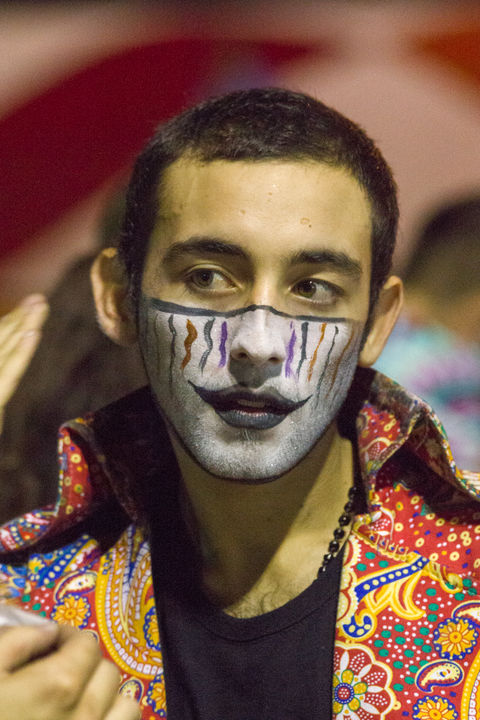Murga
Montevideo, Uruguay
"What are you doing tonight? OK, if you're not doing anything, you should definitely go to the Velódromo and see the murgas."
Carnival in Brazil may be better known, but Carnaval in Uruguay lasts longer. It kicks off in late January, and then continues for forty days (or longer, if it rains at any point). Weekends are marked by colorful parades of greater or lesser size, with each town putting on as much of a show as it can manage. In Montevideo, there are also tablados – performances by musical groups – at various locations in the city on a nightly or almost nightly basis.
The largest and most spectacular performances take place at the Velódromo. Following K.'s advice, we made the long trek from our hotel, bought our tickets, and went in to see what the fuss was all about.
Inside the Velódromo, there was a kind of picnic atmosphere. Like us, the majority of the crowd had not paid for the numbered seats closest to the stage. Instead, they simply sprawled wherever they wanted, on the bleachers further away, or on the grass inside the cycle track. Two long rows of kiosks on either side of the stage sold food and drink for those who had forgotten to pack a picnic of their own. Small children, uninterested by the song and dance on stage, ran around making their own amusement. Or, more precisely, they slid around. The steeply-banked cycle track proved irresistible. Children of all ages scavenged up anything that they could find – pieces of cardboard, flattened plastic drinks bottles – and turned them into impromptu sleds. Those who couldn't find anything to sit on simply sat down and slid, to the immediate detriment of their clothing. The brightly-lit track was speckled with small children climbing slowly up and then zooming back down.
The main attraction for those over the age of ten was not the cycle track, but the performances taking place on the main stage. A Uruguayan murga group consists of about ten to fifteen singers, led by one or two chorus leaders, and backed by a percussion section whose members play portable bass drums, snares and cymbols. Members are typically male, and wear makeup and brightly-colored clothing, sometimes accessorized by improbable hats. For some reason, most of the groups we saw were also accompanied by one or more small children, who spent the performance hovering close to the front of the stage with a pleased but bewildered expression, trying their best not to fall off the stage or get trampled by any of the gyrating adults behind them.
Murga, described as 'musical theater', is a kind of intersection between a capella, dance, and clowning. The groups perform original songs of their own invention, typically topical and satirical. The nightly tablados at the Velódromo are an ongoing competition, with each group performing multiple times during the forty days of Carnaval, and the standards are high. The rapidity of the Spanish and the layers of allusion make the songs almost impenetrable to outsiders – local friends admitted that they didn't always understand what the songs were about either – but the music is enjoyable and the performances are intensely colorful.
When we went, the first group on stage were Los Patos Cabreros ('Goatherd Ducks'), who wore black-and-white dusters printed with pictures of the Three Stooges. They were followed by Falta y Resto, dressed in long colorful overcoats that the Biblical Joseph would have envied, and sporting top hats crowned by figures of circus performers. Last – or at least last of the groups that we saw, because the murga continued long into the night – came La Gran Muñeca ('The Big Doll'), who wore elaborate skirted coats and preposterous headgear, and swirled and spun around the stage like improbable sea creatures.
It was all very colorful, very tuneful, and almost completely incomprehensible.
